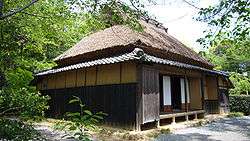Kunio Yanagita
| Kunio Yanagita 柳田 國男 | |
|---|---|
|
Kunio Yanagita, circa 1940 | |
| Born |
Kunio Matsuoka July 31, 1875 Fukusaki, Hyōgo Prefecture |
| Died |
August 8, 1962 (aged 87) Tokyo, Japan |
| Nationality | Japanese |
| Occupation | Bureaucrat, Scholar, Writer |
| Known for |
Tōno Monogatari (遠野物語) Momotarō no Tanjō(桃太郎の誕生) Nihon mukashibanashi meii ("Japanese Folk Tales") |
| Spouse(s) | Taka Yanagita (1904) |
| Parent(s) |
Yakusai Matsuoka (father) Naohei Yanagita (father-in-law) |
Kunio Yanagita (柳田 國男 Yanagita Kunio, July 31, 1875 – August 8, 1962) was a Japanese scholar and considered the father of Japanese native folkloristics, or minzokugaku.[1]
Born Kunio Matsuoka in Fukusaki, Hyōgo Prefecture to Yakusai Matsuoka, a local physician. The fifth of eight children, Yanagita's prospects of inheritance were poor. A prominent court justice with no sons, Naohei Yanagita saw the ambitious Matsuoka a promising heir and offered his daughter Taka's hand in marriage in exchange for adopting the family name. Kunio recognized the benefit of adopting the Yanagita name, and was formally adopted into the family in 1901.[2]
After graduating with a degree in law from Tokyo Imperial University, he became employed as a bureaucrat in the Ministry of Agriculture and Commerce. In the course of his bureaucratic duties, Yanagita had the opportunity to travel throughout mainland Japan. During these business trips, Yanagita became increasingly interested in observing and recording details pertaining to local village customs. Under the influence of literary friends such as the writer Shimazaki Toson, Yanagita published works supposedly based on local oral traditions such as Tales of Tono (1912). He collaborated extensively with folklorist Kizen Sasaki, and they published several books together.
Yanagita's focus on local traditions was part of a larger effort to insert the lives of commoners into narratives of Japanese history. He argued that historical narratives were typically dominated by events pertaining to rulers and high-ranking officials. Yanagita claimed that these narratives focused on elite-centered historical events and ignored the relative uneventfulness and repetition that characterized the lives of ordinary Japanese people across history. He emphasized the unique practices of different groups of common people, such as sanka or mountain dwellers, and island dwellers. His work is frequently groundbreaking and sometimes has unique cultural records.[3]
Major works

- Tōno Monogatari (遠野物語)
- a record of folk legends (as opposed to a folk tale) gathered in Tono, Iwate Prefecture. Famous yōkai in the stories include kappa and zashiki-warashi.[4]
- Kagyūkō (蝸牛考)
- Yanagita revealed that the distribution of dialects for the word snail forms concentric circles on the Japanese archipelago.
- Momotarō no Tanjō (桃太郎の誕生)
- He depicted some facets of Japanese society by analyzing the famous folk tale Momotaro. His methodology was followed by many ethnologists and anthropologists.
- Kaijō no Michi (海上の道)
- He sought the origin of the Japanese culture in Okinawa, though many of his speculations were denied by later researchers. He was inspired by picking up a palm nut borne by the Kuroshio Current when he was wandering on a beach in Iragomisaki, Aichi Prefecture.
- Yanagita Kunio Guide to the Japanese Folk Tale
- An English translation of Nippon no Mukashibanashi, a collection of Japanese folktales assembled by Yanagita Kunio, translated by Fanny Hagin Mayer.[5]
See also
- Center versus periphery: Yanagita's theory about dialectal diffusion and vocabulary propagation over time
- Nihonjinron
- Yanagita・Matsuoka Family Memorial (Japanese)
Notes
- ↑ Mori, Koichi (1980). Yanagita Kunio: An Interpretive Study. Nanzan University: Japanese Journal of Religious Studies.
- ↑ Yonemoto, Marcia (2016). The Problem of Women in Early Modern Japan. University of California Press. ISBN 9780520292000.
- ↑ Yokoyama, Manabu (1987). Ryûkyû koku shisetsu torai no kenkyû 琉球国使節渡来の研究. Tokyo: Yoshikawa kôbunkan.
- ↑ Yanagita, Kunio; Translated by Ronald A. Morse (2008). The Legends of Tono. Lexington Books. ISBN 978-0-7391-2767-4.
- ↑ Yanagita, Kunio; Translated by Fanny Hagin Meyer (1986). Yanagita Kunio Guide to the Japanese Folk Tale. Indiana University Press. ISBN 0-253-36812-X.
References
| Wikimedia Commons has media related to Yanagita Kunio. |
